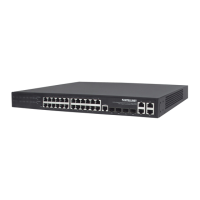Item Description
Instance Select the instance ID.
Port Fast The time Spanning Tree Protocol (STP) takes to transition ports over to the forwarding state
can cause problems. Port-fast is a function to resolve this problem. Port-fast solves the
problem of delays when client computers are connecting to switches. With port-fast enabled
on a port, you eectively prevent the implementation of STP on that port.
Auto Edge By default, “auto-edge” is enabled on all ports. This will look for BPDUs for 3 seconds and,
if none are found, will begin forwarding packets, and the port is set as “edge.” If there are
BPDUs, the port is set as “non-edge.”
BPDU Guard BPDU guard disables the port upon BPDU reception if port-fast is enabled on the port. This
eectively denies devices connected to these ports from participating in the designed STP,
thus protecting your data-center core.
BPDU Filter Enabling BPDU ltering for a port stops sending or receiving BPDU on this interface; this is
the same as disabling spanning tree on the interface. It is a risky choice, unless you are sure
that no switch can ever be connected to this port.
TC Guard In certain situations it can be desirable to prevent topology changes originating at or
received at a given port from being propagated to the rest of the network. This may be the
case when the network is not under a single administrative control and it is benecial to
prevent devices external to the core of the network from causing MAC-address ushing in
the core. This behavior can be enabled by conguring Topology Change Guard (TC Guard) on
the port.
Priority If a loop occurs in the network, MSTP uses the port priority parameter when selecting an
interface to put into the forwarding state. Assign higher priority values (lower numbers) to
interfaces that you want selected rst and lower priority values (higher numbers) that you
want selected last. If all interfaces have the same priority value, MSTP puts the port with the
lowest interface number in the forwarding state and blocks the other ports.
Path Cost The MSTP path cost default value is derived from the media speed of an interface. If a loop
occurs, MSTP uses cost when selecting an interface to put in the forwarding state. Assign
lower cost values to interfaces that you want selected rst and higher cost values that you
want selected last. If all interfaces have the same cost value, MSTP puts the interface with the
lowest interface number in the forwarding state and blocks the other interfaces.
Point to
Point
Admin Point-to-Point Link--Specify whether this port is connected to a shared LAN segment
(value “o”) or a point-to-point LAN segment (value “on”). A point-to-point LAN segment is
connected to exactly one other bridge (normally with a direct cable between them). Only
point-to-point links and edge ports can rapidly transition to forwarding state.
If you set this value to “auto,” the switch automatically detects whether the port is connected
to a shared link or a point-to-point link.
Rootguard Root-guard ensures that an unintended switch does not become a new root bridge. Root
guard allows the device to participate in STP as long as the device does not try to become
the root. If root guard blocks the port, subsequent recovery is automatic. Recovery occurs as
soon as the oending device ceases to send superior BPDUs.
TC Ignore Ignore technology change (TC) on or o.
DHCP RELAY
A DHCP client is an Internet host using DHCP to obtain conguration parameters such as an IP address. A
DHCP relay agent is any host that forwards DHCP packets between clients and servers. Relay agents are used
to forward requests and replies between clients and servers when they are not on the same physical subnet.
The Intellinet Network Solutions switch can fulll the role of such a relay agent.

